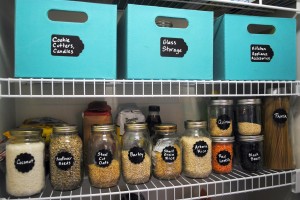At home, in order to have choices for your daily meals, it is very important to give yourself a fighting chance. If you don’t have basic staples in your pantry and refrigerator, it is impossible to build a meal.
You know the story: family members come home and the first thing they say is, “Mooooommmm! What have you got to eat?” or, “Awwww, isn’t there ANYTHING good here in the cupboard??” Then boom, it is off to fast-food city or into the snack stash and the poor eating begins. This is certainly true for golfers who are in a rush to get to the course and will scrimp on proper foods. Eat poorly and your performance will suffer. Instead, here are some suggestions to use in stocking a well-appointed pantry so you can be prepared. Keep these items on hand and your family will always have good food to eat….with a little prep.
Oils and Vinegars: an assortment of olive, canola, and savory oils as well as Balsamic, Red Wine, and flavored vinegars do wonders for snazzing up salads as well as sautéing foods. Exotic oils like sesame or walnut oil offer a change of pace, especially for Asian dishes or other ethnic offerings.
Seasonings and Condiments: my favorites are garlic powder, spice/herb blends (Cajun and Herbs de Provence), lemon pepper, Mrs. Dash, BBQ sauce, Dijon mustard, Wasabi, Red Hot, salsa; watch the ketchup though: too much sugar and salt, plus the 100 calories per tablespoon is a waste of your daily calorie intake.
Canned Beans: black, navy, red, and Garbanzo all add folate and fiber to your diet. Four bean salads with a vinaigrette dressing and other chopped vegetables is a powerful dose of protein and great to consume before golf.
Assorted Nuts: walnuts, almonds, pecans, pistachios, hazelnuts, and macadamias will all add distinctive taste and elegance to any dish, especially rice. Toast them in the oven for a real treat! pack some in a baggie to stash in your golf bag.
Canned or Vacuum-Packed Fish: tuna and salmon are all great for Omega-3’s and protein. You can put a pouch of tuna in your golf bag too…..pure protein.
Sliced Olives, Artichoke Hearts, Pickles, and Peppers: olives always add a stylish kick to all foods; peppers of any sort pack a flavor blast, and pickles do wonders for staples like potato salad or tuna salad; artichokes create a nice pungency to pastas and chicken dishes.
Tomato Products: diced tomatoes, tomato sauce (NOT spaghetti sauce though you can use it in a pinch as a supplement – way too much sugar and salt….), tomato paste are great for quick pizza toppings, in stews, sauces, and soups. Some have herbs in them already for extra flavor.
Dried foods: cherries, apricots, raisins, prunes, tomatoes, and mushrooms all provide a great burst of flavor to anything. Morel mushrooms are extravagant, but taste one and you’re done!
Chicken Broth and Evaporated Milk: use these for soups and stews; fat free sounds nice but you really do need a little bit of fat to provide maximum flavor. If you buy CostCo or Sam’s Club rotisserie chickens, boil the carcass and save the liquid for homemade broth.
Rice and Whole Grains: go beyond white rice and try Basmati, Jasmine or other exotics. Grains like couscous, quinoa (pronounced ‘Keen-wah’), barley, bulgur, lentils, and oatmeal pack super nutrients and can cook up quickly. Make extra so they’re handy to add to your fave dishes.
Whole Wheat Pasta: I challenge anyone to know the difference from plain white pasta. Whole wheat is a bit more chewy but as far as taste, it’s a draw.
Sea Salts and Whole Peppercorns: anything you can grind fresh always tastes better. Flavored salts are fun to try – ever had truffle salt? Yes, the sodium is still there, but fresh ground taste is more alive and you will use less.

